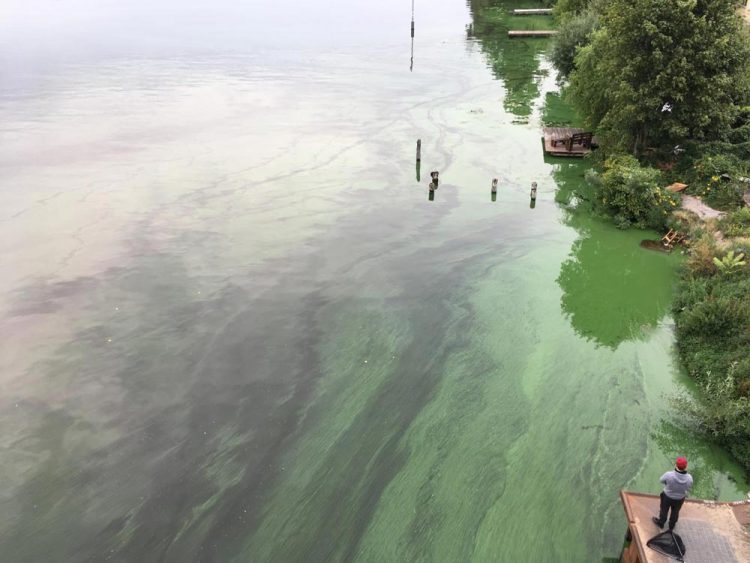Cyanobacteria in water and on land identified as source of methane

This is a cyanobacteria bloom in a lake in Germany. Credit: Angelina Tittmann
Methane generation by microorganisms is traditionally considered to take place only under strictly anoxic conditions by microbes of the domain Archaea. This assumption is refuted by the results of the present study led by Dr. Mina Bizic from IGB. The international research team investigated seventeen cyanobacterial species that occur in the sea, freshwater and soil.
“Cyanobacteria in surface water are a previously unknown source of methane and we were able to show for the first time that these bacteria produce the greenhouse gas methane during photosynthesis,” states Dr. Mina Bizic.
To do so, Thomas Klintzsch from Heidelberg University used isotopically labelled carbon to evaluate how methane is formed in the cell during the conversion of light energy into chemical energy.
In laboratory experiments, the team compared the amount of methane produced by Cyanobacteria with the amounts produced by methanogenic archaea and organisms with cell nuclei (eukaryotes).
“Cyanobacteria produce less methane than archaea, but more methane than eukaryotes. It is difficult to estimate the global amount of methane produced by Cyanobacteria because there is a severe lack of detailed data on the biomass of these organisms in water and soil,” says co-author Frank Keppler, Professor at the Institute of Earth Sciences at Heidelberg University.
More blue-green algal blooms mean higher methane emissions
It may be that Cyanobacteria have been producing the greenhouse gas methane already since the early days of Earth. Cyanobacteria are well known for the Great Oxygenation event that took place 2.5 billion years ago, but the oldest known fossils (stromatolites) are deposits of Cyanobacteria¬-like organism found in 3.5 billion-year-old rocks in Western Australia.
Cyanobacteria are widespread all over the world occurring in almost any illuminated environment. Some species develop particularly well in seawater or fresh water with high nutrient loads and warm temperatures.
As a result of climate change, mass developments, so-called cyanobacteria or blue-green algae blooms, already occur more frequently and will do so to a greater extent in the future.
“According to our current findings, this will also increase the emission of the greenhouse gas methane from various aquatic systems, which in turn increases climate change,” says senior author Prof. Hans-Peter Grossart, researcher at IGB.
Media Contact
All latest news from the category: Life Sciences and Chemistry
Articles and reports from the Life Sciences and chemistry area deal with applied and basic research into modern biology, chemistry and human medicine.
Valuable information can be found on a range of life sciences fields including bacteriology, biochemistry, bionics, bioinformatics, biophysics, biotechnology, genetics, geobotany, human biology, marine biology, microbiology, molecular biology, cellular biology, zoology, bioinorganic chemistry, microchemistry and environmental chemistry.
Newest articles

Properties of new materials for microchips
… can now be measured well. Reseachers of Delft University of Technology demonstrated measuring performance properties of ultrathin silicon membranes. Making ever smaller and more powerful chips requires new ultrathin…

Floating solar’s potential
… to support sustainable development by addressing climate, water, and energy goals holistically. A new study published this week in Nature Energy raises the potential for floating solar photovoltaics (FPV)…

Skyrmions move at record speeds
… a step towards the computing of the future. An international research team led by scientists from the CNRS1 has discovered that the magnetic nanobubbles2 known as skyrmions can be…





















